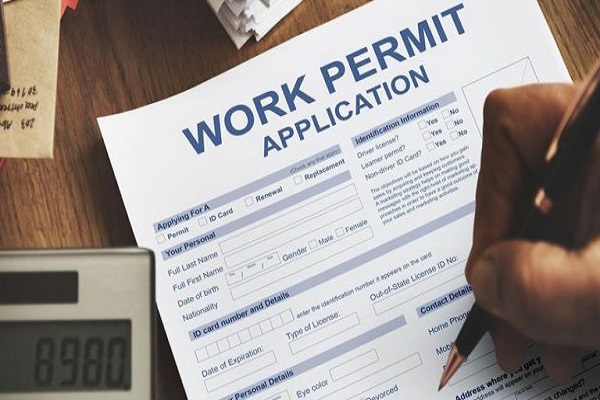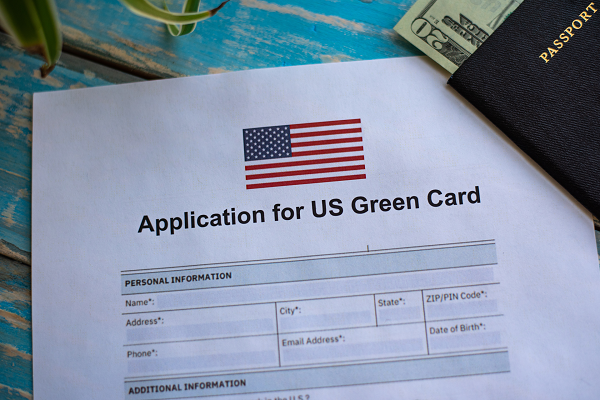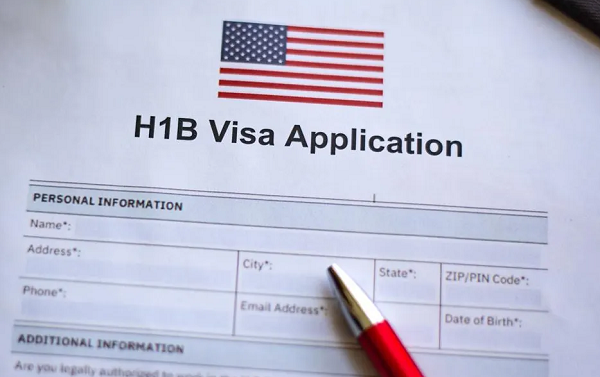Work Permit USA is a critical legal document for foreign nationals seeking employment in the United States. Also known as an Employment Authorization Document (EAD), this permit legally allows non-citizens to work across various industries in the U.S. economy.
Whether you’re a student on an F-1 visa, an asylum seeker, a spouse of a visa holder, or applying for adjustment of status, understanding the nuances of the Work Permit USA process is essential for building your future in the United States.
In this guide, we will walk you through the essential aspects of obtaining a work permit USA, helping you unlock the door to countless career possibilities in this dynamic nation.
What Is a Work Permit USA?
The Work Permit USA, officially called the Employment Authorization Document (EAD), is issued by the U.S. Citizenship and Immigration Services (USCIS). It proves that you are legally allowed to work in the United States for a specific time frame.
The document is a plastic card similar in appearance to a driver’s license. It contains vital information such as:
- Full name
- Alien registration number (A-number)
- Photograph
- Validity period (usually 1–2 years)
While certain visa categories automatically allow work (like H-1B), many immigrants must apply separately for a Work Permit USA to be lawfully employed.
Who Needs a Work Permit in the USA?
You need a Work Permit USA if:
- You are applying for asylum or refugee status
- You are on a student visa (F-1) and seeking Optional Practical Training (OPT) or Curricular Practical Training (CPT)
- You are a spouse of an H-1B, L-1, or E-2 visa holder
- You are applying for a Green Card (adjustment of status)
- You are under Deferred Action for Childhood Arrivals (DACA)
- You fall under Temporary Protected Status (TPS)
Without a valid Work Permit USA, engaging in paid work may lead to immigration penalties, including visa denial, deportation, or a bar on re-entry.
Types of Work Permit USA
1. Work Permit for Adjustment of Status Applicants (Green Card Applicants)
Who qualifies: Foreign nationals applying for lawful permanent residence (Green Card) in the U.S.
Key benefit: Work legally while your I-485 (Green Card) application is pending.
Valid for: 1 or 2 years, renewable if adjustment is still pending.
2. DACA Work Permit (Deferred Action for Childhood Arrivals)
Who qualifies: Undocumented immigrants who arrived in the U.S. as children and meet DACA requirements.
Key benefit: Renewable 2-year work authorization.
Must also: Apply for DACA protection simultaneously or renew both.
3. Asylum Seekers and Refugees
Asylum Applicants
Who qualifies: Individuals with pending asylum cases (after 150 days of wait).
Valid for: 1 year, renewable while asylum is pending.
Approved Asylees or Refugees
Who qualifies: Individuals granted asylum or admitted as refugees.
Note: Automatically authorized to work, but can request EAD as proof.
4. F-1 Student Work Permits
F-1 visa holders may qualify for different kinds of employment authorization:
a. OPT (Optional Practical Training)
Valid for: 12 months (can be extended by 24 months for STEM grads)
Work must relate to your field of study
b. CPT (Curricular Practical Training)
Work authorization for training integral to curriculum
Does not require EAD, but authorization comes from Designated School Official (DSO)
5. Work Permits for Spouses of Visa Holders
a. H-4 Visa Spouses
Who qualifies: Spouses of H-1B holders with approved I-140 (green card petition)
Apply for: EAD separately with Form I-765
b. L-2 Visa Spouses
Who qualifies: Spouses of L-1 visa holders
Note: Automatically authorized to work as of recent rule change; can still apply for EAD if needed
c. E-2 Visa Spouses
Who qualifies: Spouses of E-2 treaty investors or traders
Work rights granted automatically, but may apply for EAD as proof
6. Temporary Protected Status (TPS) Work Permits
Who qualifies: Nationals from designated countries facing war, disaster, or epidemic
Can apply: For EAD during TPS registration period
Valid for: Length of TPS designation, often 18 months
7. Work Permit for Parolees
Who qualifies: Foreign nationals paroled into the U.S. for urgent humanitarian or public interest reasons.
Work permit needed: Must apply for and receive EAD to work
8. Work Permit for VAWA Self-Petitioners
Who qualifies: Victims of domestic violence under the Violence Against Women Act (VAWA)
Granted after: Approval of Form I-360
Allows: Employment and lawful stay during adjustment process
9. U and T Visa Holders
a. U Visa (Victims of Crimes)
Issued to: Victims of qualifying crimes cooperating with law enforcement
b. T Visa (Victims of Human Trafficking)
Both visas: Provide work authorization with approved visa
Type of Work Visas in USA
1. H-1B Visa:
The H-1B visa is one of the most sought-after work visas in USA. It is designed for highly skilled professionals, particularly in fields like technology, engineering, and science. To obtain an H-1B visa, an employer must sponsor the applicant, and the position must require specialized knowledge or expertise.
2. L-1 Visa:
The L-1 visa is for intracompany transferees. It allows multinational companies to transfer their employees from a foreign office to a U.S. branch. There are two subcategories: L-1A for managers and executives and L-1B for employees with specialized knowledge.
3. Visa:
The O visa is intended for individuals with extraordinary abilities or achievements in fields such as arts, sciences, education, business, or athletics. To qualify for an O visa, applicants must demonstrate their outstanding achievements and receive sponsorship from a U.S. employer or agent.
4. TN Visa:
The TN visa is available for Canadian and Mexican citizens under the United States-Mexico-Canada Agreement (USMCA). It allows professionals in various occupations to work in USA temporarily. This visa category does not require sponsorship by a U.S. employer.
5. E-3 Visa:
The E-3 visa is exclusively for Australian citizens who wish to work in specialty occupations. Similar to the H-1B visa, applicants must have a job offer from a U.S. employer and meet specific educational and professional requirements.
6. Green Card (Permanent Residency):
A green card, or permanent residency, allows foreign nationals to live and work in USA indefinitely. Various pathways lead to obtaining a green card, including family sponsorship, employment sponsorship, and refugee/asylee status.
7. Optional Practical Training (OPT):
OPT is a work authorization for international students in USA. It allows them to work in their field of study for up to 12 months after completing their degree (and potentially up to 36 months for STEM graduates) without needing a separate work visa.
8. Asylum Employment Authorization:
Asylum seekers who have filed for asylum may apply for work authorization while their asylum application is pending.
9. Refugee Employment Authorization:
Refugees resettled in the U.S. are generally eligible for work authorization.
10. DACA (Deferred Action for Childhood Arrivals):
DACA recipients, also known as Dreamers, who meet certain criteria, may be granted work authorization and temporary protection from deportation.
Requirements For Applying For A Work Permit In USA in 2025
Obtaining a work permit (also known as an Employment Authorization Document or EAD) in the United States typically involves specific requirements and a formal application process.
The eligibility criteria and process may vary based on your immigration status, the type of work you intend to do, and other factors.
Here are some general steps and requirements for applying for a work permit in USA:
1. Determine Eligibility:
Ensure that you are eligible for a work permit. Eligibility can depend on factors such as your immigration status, pending asylum or refugee status, or eligibility under certain visa categories.
2. File the Appropriate Application:
You will need to file the appropriate application form with U.S. Citizenship and Immigration Services (USCIS). The specific form you need to use depends on your circumstances. The most commonly used form for general work permits is the Form I-765, Application for Employment Authorization.
3. Pay the Application Fee:
There is usually a fee associated with filing the work permit application. Check the USCIS website for the most up-to-date fee information.
4. Gather Supporting Documents:
You will need to provide supporting documentation, such as a copy of your current immigration status documents, passport photos, and any required evidence to establish your eligibility. The exact documents can vary based on your situation.
5. Complete the Form I-765:
Fill out the Form I-765 accurately and completely. Follow the instructions provided with the form and be sure to sign it.
6. Submit the Application:
Mail your completed application form, supporting documents, and the application fee to the appropriate USCIS address. Make sure to keep copies of everything for your records.
7. Biometrics Appointment (if required):
USCIS may schedule you for a biometrics appointment to collect your fingerprints, photograph, and signature.
8. Wait for Processing:
USCIS will process your application, which can take several months. You can check the status of your application on the USCIS website.
9. Receive the EAD Card:
If your application is approved, you will receive an Employment Authorization Document (EAD) card. This card will specify the period for which you are authorized to work in the United States.
10. Maintain Valid Status:
Once you have your work permit, you must maintain your immigration status and adhere to any specific conditions or restrictions associated with your work permit.
Documents Required To Apply For A Work Permit In USA
To apply for a work permit (officially known as an Employment Authorization Document or EAD) in the United States, you will typically need to follow a specific process and provide certain documents.
The specific requirements may vary depending on your individual circumstances and visa category, but here are the common documents and steps you will likely need:
1. Form I-765:
Complete Form I-765, Application for Employment Authorization. This form can be downloaded from the U.S. Citizenship and Immigration Services (USCIS) website.
2. Fees:
Pay the required filing fee for Form I-765, unless you are eligible for a fee waiver. Check the USCIS website for the most up-to-date fee information.
3. Supporting Documents:
Depending on your eligibility category, you may need to provide specific supporting documents along with your Form I-765. Here are some examples:
4. Passport-sized photos:
You may need to include passport-sized photos as per USCIS specifications.
- Copy of your current visa or immigration status document.
- Copy of your passport and previous EAD cards, if applicable.
- Marriage certificate, if you are applying as a spouse of a U.S. citizen or a lawful permanent resident.
- Form I-94, Arrival/Departure Record.
- Form I-20 (for F-1 students) or Form DS-2019 (for J-1 exchange visitors).
- Job offer letter or employment contract, if required by your category.
5. Form G-1145:
If you want to receive electronic notifications about your application status, you can include Form G-1145, E-Notification of Application/Petition Acceptance.
6. Form I-797:
If you have a pending immigration application or petition, you may need to include a copy of Form I-797, Notice of Action, as proof of your eligibility.
7. Translation and Certification:
If any of your documents are not in English, you will need to provide a certified translation along with the original documents.
8. Optional Cover Letter:
While not required, you can include a cover letter that summarizes your application and explains any special circumstances or additional documents you are submitting.
How To Apply For A Work Permit In USA – Step-by-Step
If you’re considering working in the United States, it’s essential to understand the process of obtaining a work permit in USA.
A work permit, also known as an Employment Authorization Document (EAD), is a crucial document that allows foreign nationals to legally work in the country.
Here, we will walk you through the steps to apply for a work permit in USA, ensuring that work permit in USA becomes a seamless reality for you.
1. Determine Your Eligibility:
Before diving into the application process, it’s vital to determine if you are eligible for a work permit in USA. Eligibility criteria vary depending on your visa status, relationship to a U.S. citizen, asylum status, or other unique circumstances. Make sure you meet the requirements to avoid any complications during the application process.
2. Select the Appropriate Work Visa:
To apply for a work permit in USA, you generally need to have a valid visa that allows you to work. Choose the right visa category that aligns with your employment intentions, such as an H-1B for skilled workers, an L-1 for intracompany transfers, or an F-1 Optional Practical Training (OPT) for students. Your chosen visa category should match your qualifications and job offer.
3. Secure a Job Offer:
To apply for a work permit in USA, you typically need a job offer from a U.S. employer. Ensure your prospective employer is willing to sponsor your work permit application, as they may need to complete specific paperwork and attest to your eligibility for the position.
4. File Form I-765:
The Form I-765, Application for Employment Authorization, is the primary document used to apply for a work permit in USA. Carefully complete the form, providing accurate information about your immigration status, employment category, and personal details. Ensure you submit the necessary supporting documents, including your visa, passport, and job offer letter.
5. Pay the Required Fees:
There is a fee associated with filing Form I-765. Be sure to check the U.S. Citizenship and Immigration Services (USCIS) website for the most up-to-date fee information and payment methods. Keep a record of your payment receipt for your records.
6. Wait for Processing:
After submitting your application, you’ll need to patiently wait for USCIS to process it. Processing times can vary, so it’s essential to check USCIS’s website or use their online tools to track your application’s status.
7. Attend Biometrics Appointment (if required):
Some applicants may be asked to attend a biometrics appointment, where your fingerprints, photograph, and signature will be taken. Follow the instructions provided by USCIS and attend the appointment as scheduled.
8. Receive and Use Your Work Permit:
Once your work permit application is approved, you will receive your EAD card. This card allows you to work legally in USA for the specified period mentioned on the card. Make sure to carry your EAD card with you and provide it to your employer as proof of your work authorization.
Tips For Successful Application Of Work Permit In USA
A successful work permit application can be crucial if you’re planning to work legally in a foreign country. The specific requirements and process can vary greatly from one country to another, so it’s essential to research the specific requirements of the country where you intend to work.
However, here are some general tips that can help you with a successful work permit application:
1. Research and Understand the Requirements:
Start by thoroughly researching the specific requirements for a work permit in the country you’re interested in. Each country has its own rules, eligibility criteria, and application procedures. Make sure you meet all the prerequisites.
2. Choose the Right Visa Category:
Determine the correct visa category or type of work permit you need based on your intended job, qualifications, and circumstances. Some common categories include skilled worker visas, temporary work visas, and intra-company transfer visas.
3. Prepare Necessary Documentation:
Collect all required documents well in advance. Commonly required documents include a valid passport, a job offer letter, educational qualifications, proof of funds, and any required certifications or licenses. Make sure your documents are up to date and translated into the language of the country if necessary.
4. Meet Health and Character Requirements:
In many countries, applicants need to undergo medical examinations and provide police clearance certificates to prove their health and character. Ensure you meet these requirements and complete the necessary tests or checks.
5. Financial Documentation:
Some countries may require proof that you have enough funds to support yourself during your stay. This could include bank statements, financial guarantees, or sponsorship letters.
6. Complete the Application Form Accurately:
Fill out the application form carefully, providing accurate and complete information. Follow the instructions precisely and ensure that there are no errors or inconsistencies in your application.
7. Pay the Required Fees:
Be prepared to pay any processing fees associated with your work permit application. Ensure that you pay the correct fees through the designated payment methods.
8. Seek Legal Advice:
If you’re unsure about any aspect of the application process or if you face specific challenges, consider seeking legal advice from immigration experts or lawyers who specialize in immigration matters.
9. Submit Your Application On Time:
Pay attention to application deadlines and submission procedures. Submit your application well in advance of your intended start date to allow for processing time.
10. Follow Up on Your Application:
After submitting your application, stay informed about its status. Some countries offer online tracking systems that allow you to monitor your application’s progress.
11. Prepare for an Interview:
Some countries may require an interview as part of the application process. Be prepared to answer questions about your qualifications, job offer, and intentions.
12. Maintain Communication:
If you have any changes in your circumstances (e.g., a new job offer, address change), inform the immigration authorities promptly to avoid any issues.
13. Be Patient:
Processing times for work permits can vary widely. Be patient and prepared for potential delays.
What Are The Processes Of Obtaining Work Permit In USA Through H1B Visa Program
Obtaining a work permit in USA through the H-1B visa program involves several steps and processes. The H-1B visa is designed for foreign nationals who are offered employment in the United States in a specialty occupation, which typically requires a bachelor’s degree or higher. Here’s an overview of the key steps:
1. Find an H-1B Sponsor:
You must first secure a job offer from a U.S. employer who is willing to sponsor your H-1B visa. The employer must submit a Labor Condition Application (LCA) to the Department of Labor (DOL) and obtain approval before proceeding.
2. Filing the H-1B Petition:
Once the LCA is approved, your employer will file an H-1B petition (Form I-129) with the U.S. Citizenship and Immigration Services (USCIS). This petition includes supporting documentation such as the job offer, educational qualifications, and other required forms.
3. H-1B Lottery (if applicable):
The demand for H-1B visas often exceeds the annual cap, which is set by Congress. If your application is subject to the cap and more petitions are received than available visas, a random lottery is conducted to select the beneficiaries who will be considered for processing.
4. USCIS Processing:
If your H-1B petition is selected in the lottery, it will undergo USCIS processing. This involves reviewing the petition and verifying its eligibility. USCIS may request additional documentation or information during this process.
5. USCIS Approval:
If your H-1B petition is approved, you will receive a Form I-797 Notice of Approval. This notice serves as your work authorization document.
6. Consular Processing (if outside the U.S.):
If you are outside the United States, you will need to attend an interview at a U.S. consulate or embassy to obtain an H-1B visa stamp in your passport. You will need to present your Form I-797 and other required documentation during the interview.
7. Entering the U.S.:
Once you have obtained an H-1B visa stamp, you can travel to the United States and present your visa and Form I-797 at the port of entry. You will be admitted to the U.S. in H-1B status.
8. Employment:
You can begin working for your sponsoring employer in the specified specialty occupation as mentioned in your H-1B petition. Your employment is tied to your sponsoring employer, and changing employers requires a new H-1B petition.
9. Extension or Change of Status:
If you wish to extend your H-1B status or change employers, your new employer must file a new H-1B petition on your behalf. USCIS will need to approve this petition for you to continue working in the United States.
How The Employment-Based Green Card Categories Can Lead To Work Permits For Foreign Nationals
If you’re a foreign national working in the United States and dreaming of a long-term career here, you might be wondering how to get a work permit or even a green card.
The employment-based green card categories offer a pathway to both. Let’s break it down into simple terms.
1. Understanding Employment-Based Green Cards:
Employment-based green cards, also known as EB visas, are designed to help foreign workers become permanent residents (green card holders) in the U.S. There are several categories, but we’ll focus on the most common ones:
- EB-1: For individuals with extraordinary abilities, outstanding professors, researchers, and multinational managers or executives.
- EB-2: For professionals with advanced degrees or exceptional abilities in their field.
- EB-3: For skilled workers, professionals, and other workers with job offers in the U.S.
- EB-4: For special immigrants, like religious workers or employees of international organizations.
- EB-5: For investors who create jobs by investing in U.S. businesses.
2. The Green Card Process:
To get a green card through employment, here’s a simplified process:
- Step 1: Find an Employer: You need a job offer from a U.S. employer who is willing to sponsor you for a green card.
- Step 2: Labor Certification (EB-2 and EB-3 only): For EB-2 and EB-3, your employer must prove that no qualified U.S. workers are available for your job. This step can take some time.
- Step 3: File the Petition: Your employer files an immigration petition on your behalf, based on the appropriate employment category.
- Step 4: Wait for Visa Numbers: Due to annual limits, you might need to wait until a visa number becomes available. Priority is given to higher preference categories.
- Step 5: Apply for Adjustment of Status or Consular Processing: Once a visa number is available, you can apply for a green card through adjustment of status (if you’re already in the U.S.) or consular processing (if you’re outside the U.S.).
3. Work Permits While Waiting:
While waiting for your green card, you can also apply for a work permit, officially known as an Employment Authorization Document (EAD). To do this, you should file Form I-765 with U.S. Citizenship and Immigration Services (USCIS).
4. Temporary Work Visas:
If you’re not eligible for an employment-based green card yet, you might consider temporary work visas like H-1B, L-1, or O-1. These visas allow you to work in the U.S. for a specific period, and some of them can be a stepping stone to a green card.
5. Seek Legal Guidance:
Navigating the immigration process can be complex, so it’s wise to consult with an immigration attorney or use reliable online resources to ensure you’re on the right track.
The Optional Practical Training For Students
Optional Practical Training (OPT) is a program in the United States that allows international students with F-1 visas to gain practical experience related to their field of study.
OPT is intended to provide students with the opportunity to apply their academic knowledge in a practical setting and enhance their skills. Here are some key points to know about OPT for students:
To be eligible for OPT, you must be an F-1 student who has been enrolled full-time for at least one academic year in a degree program at a U.S. educational institution that is SEVP (Student and Exchange Visitor Program) certified.
F-1 students are typically eligible for up to 12 months of OPT per degree level. However, certain STEM (Science, Technology, Engineering, and Mathematics) degree holders may be eligible for a 24-month STEM OPT extension.
To apply for OPT, you must request authorization from your Designated School Official (DSO) at your educational institution. They will guide you through the application process and help you submit the necessary paperwork to the U.S. Citizenship and Immigration Services (USCIS).
Once approved for OPT, you can work in a job related to your field of study. You can work part-time (up to 20 hours per week) during your studies and full-time during authorized periods of OPT.
How to Renew Your Work Permit in USA
Renewing your work permit in USA is crucial for foreign nationals looking to continue their employment legally. A work permit, also known as an Employment Authorization Document (EAD), allows non-U.S. citizens to work legally within the country. In this comprehensive guide, we’ll walk you through the process of renewing your work permit in USA, highlighting key steps and important information related to work permits in USA.
1. Understanding Work Permits in USA:
Before we delve into the renewal process, let’s briefly review the basics of work permits in the USA. A work permit is an official document issued by the U.S. Citizenship and Immigration Services (USCIS) that grants temporary authorization for employment. It’s typically valid for one to two years and is renewable in most cases.
2. Determine Eligibility for Renewal:
To renew your work permit, you must meet certain eligibility criteria. Generally, you can renew if you are still eligible for the same employment category as your initial EAD. However, ensure you apply for renewal at least 120 days before your current EAD expires.
3. Gathering Required Documents:
Collect the necessary documents, including the Form I-765 (Application for Employment Authorization) and any supporting documents requested by USCIS. Pay close attention to details and deadlines to avoid processing delays.
4. Complete Form I-765:
Properly fill out Form I-765, ensuring you check the box for “Renewal of my permission to accept employment.” Provide accurate information, and be prepared to explain any changes in your eligibility or circumstances.
5. Submitting the Application:
Submit your completed Form I-765, supporting documents, and the required fee to USCIS. Be sure to retain copies of your application for your records.
6. Biometrics Appointment:
In some cases, USCIS may require you to attend a biometrics appointment to provide fingerprints, photographs, and other biographical information. Attend the appointment as scheduled.
7. Wait for Processing:
USCIS will process your renewal application. It can take several months, so be patient. You can check the status of your application online using your receipt number.
8. Receive Your Renewed Work Permit:
Once approved, you’ll receive your renewed work permit by mail. It will include a new expiration date, allowing you to continue working legally in USA.
9. Updating Your Employer:
Inform your employer of the renewed work permit and provide them with a copy for their records. Ensure they update their records accordingly.
10. Plan Ahead:
As your renewed work permit approaches its expiration date, start the renewal process early to avoid any gaps in employment authorization.
Challenges in Obtaining a Work Permit in USA
Obtaining a work permit in the United States can be a complex process, and there are several challenges and considerations that individuals may face when attempting to secure one.
Here are some of the key challenges:
1. Eligibility Criteria:
To qualify for a work permit, you must meet specific eligibility criteria, such as being in a certain immigration status or having a pending immigration application. Not everyone is eligible, and eligibility can vary depending on your immigration status.
2. Visa Category:
Your eligibility for a work permit often depends on the type of visa you hold or the immigration status you are applying under. For example, individuals with H-1B, L-1, or O-1 visas may have an easier time obtaining a work permit compared to those in tourist (B-2) or visa waiver (ESTA) status.
3. Employer Sponsorship:
Many work permits in the U.S. are tied to employer sponsorship. This means that your employer may need to initiate the process and meet certain requirements to hire foreign workers. For example, they may need to demonstrate that there are no qualified U.S. workers available for the position.
4. Wait Times:
Processing times for work permits can be lengthy, and it may take several months to receive approval. This can be challenging if you have a job offer or need to start working sooner.
5. Immigration Status Changes:
Changes in your immigration status can affect your eligibility for a work permit. For example, if you change from one visa category to another, you may need to reapply for a work permit.
6. Legal Documentation:
You’ll need to provide a variety of legal documents, including proof of your identity, immigration status, and eligibility for a work permit. Obtaining and organizing these documents can be a time-consuming process.
7. Fees:
There are often fees associated with applying for a work permit, and these fees can vary depending on the type of work permit and your circumstances. These costs can add up, particularly if you have dependents who also need work permits.
8. Immigration Policies:
U.S. immigration policies and regulations can change over time. Changes in administration can lead to shifts in immigration policies, which may impact the eligibility criteria and application processes for work permits.
9. Competition:
The U.S. job market can be competitive, and securing a job offer from a U.S. employer willing to sponsor you for a work permit can be challenging, especially if you’re applying from abroad.
10. Immigration Attorneys:
Navigating the U.S. immigration system can be complex. Many individuals seek the assistance of immigration attorneys to help them with the application process, but legal fees can be expensive.
Frequently Asked Questions
1. Who is eligible for a work permit in USA?
Eligibility for a work permit in USA depends on your immigration status. Common categories include asylum seekers, refugees, DACA recipients, spouses of certain visa holders, and international students on F-1 visas, among others.
2. How do I apply for a work permit in USA?
The application process varies depending on your eligibility category. Generally, you must file Form I-765, Application for Employment Authorization, with U.S. Citizenship and Immigration Services (USCIS).
3. What is the processing time for a work permit application?
Processing times can vary, but USCIS typically processes EAD applications within 90 days. You can check the USCIS website for current processing times.
4. Can I work anywhere in USA with a work permit?
Your work permit may have restrictions based on your immigration status. Some work permits allow you to work for any employer, while others are limited to specific employers or industries.
5. How long is a work permit valid for?
The validity of a work permit depends on your immigration status. It can range from a few months to several years. You can find the expiration date on your EAD.
6. Can I renew my work permit?
In most cases, you can apply to renew your work permit if you remain eligible. You should apply for a renewal several months before your current EAD expires.
7. Can I work while my work permit renewal is pending?
If you file a timely renewal application before your current EAD expires, you can continue working for up to 180 days while your renewal is pending, as long as you meet certain conditions.
8. What happens if my work permit application is denied?
If your application is denied, USCIS will provide a reason for the denial. You may be able to appeal the decision or reapply with additional documentation.
9. Can I apply for a green card with a work permit?
In some cases, having a work permit can be a step toward applying for a green card (permanent residency) in USA, especially for certain visa holders or asylum seekers. However, eligibility requirements vary.
10. Do I need a Social Security Number (SSN) to work with a work permit?
Yes, in most cases, you will need a Social Security Number (SSN) to legally work in USA. You can apply for an SSN after receiving your work permit.
11. Can I travel outside the USA with a work permit?
Generally, you can travel abroad while holding a valid work permit, but you must follow specific procedures to ensure you can re-enter the country. Consult with USCIS for guidance on travel.
12. Can I apply for a work permit if I’m in USA illegally?
In some situations, individuals with pending asylum or certain visa applications may be eligible for work permits even if they are in the country without legal status. Consult with an immigration attorney for guidance in such cases.
Conclusion
Applying for a work permit in USA can be a complex process, but by following these steps and ensuring you meet the eligibility criteria, you can increase your chances of success.
Remember that staying informed and complying with U.S. immigration laws are crucial to achieving your goal of obtaining a work permit in USA.
It’s important to note that the requirements and procedures may change over time, so it’s advisable to visit the USCIS website (https://www.uscis.gov/) for the most current information and forms related to applying for a work permit in USA.
Additionally, consulting with an immigration attorney or seeking guidance from a trusted immigration organization can be helpful, especially if you have a complex immigration situation.
Reference
immigrationhelp.org – Everything You Need To Know About U.S. Work Permits (EADs)
urbinalawfirm.com – Work permit in the USA: What is it and how to obtain it?
alllaw.com – Who Qualifies for a Work Permit in the United States?






